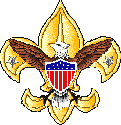| MERIT BADGES |
|
|
|
|
| Note: Eagle Required are in Italics |
"A"
American
Business
American Culture
American Heritage
American Labor
Animal Science
Archaeology
Archery
Architecture
Art
Astronomy
Athletics
Atomic Energy
Auto Mechanics
Aviation
"B"
Backpacking
Basketry
Bird Study
Bugling
"C"
Camping
Canoeing
Chemistry
Cinematography
Citizenship
Community*
Citizenship Nation*
Citizenship World*
Climbing
Coin Collecting
Collections
Communications*
Computers
Cooking
Crime Prevention
Cycling*
"D"
Dentistry
Disability Awareness
Dog Care
Drafting
"E"
Electricity
Electronics
Emergency
Preparedness**
Energy
Engineering
Entrepreneurship
Environmental
Science*
"F"
Family Life*
Farm Mechanics
Fingerprinting
Fire Safety
First Aid*
Fish & Wildlife Mgmt.
Fishing
Fly Fishing
Forestry
"G"
Gardening
Genealogy
Geology
Golf
Graphic Arts
"H"
Hiking
Home Repairs
Horsemanship
"I"
Indian Lore
Insect Studies
"J"
Journalism
"K"
"L"
Landscape Architecture
Law
Leatherwork
Lifesaving**
"M"
Mammal Study
Medicine
Metalwork
Model Design & Building
Motorboating
Music
"N"
Nature
"O"
Oceanography
Orienteering
"P"
Painting
Personal Fitness**
Personal Management*
Pets
Photography
Pioneering
Plant Science
Plumbing
Pottery
Public Health
Public Speaking
Pulp and Paper
"Q"
"R"
Radio
Railroading
Reading
Reptile & Amphibian Study
Rifle Shooting
Rowing
"S"
Safety
Salesmanship
Scholarship
Sculpture
Shotgun Shooting
Skating
Skiing
Small Boat Sailing
Soil & Water
Conservation
Space Exploration
Sports**
Stamp Collecting
Surveying
Swimming**
"T"
Textile
Theatre
Traffic Safety
Truck Transportation
"U"
"V"
Veterinary Medicine
"W"
Water Skiing
Weather
Whitewater
Wilderness Survival
Wood Carving
Woodwork
"X"
"Y"
"Z"
|
|
- Do the following:
- Tell what soil is. Tell how it is formed.
- Describe three kinds of soil. Tell how they are different.
- Describe the three main plant nutrients in fertile soil. Tell how they can be put back when used up.
- Do the following:
- Define soil erosion.
- Tell why it is important. Tell how it affects you.
- Name three kinds of soil erosion. Describe each.
- Take pictures or draw two kinds of soil erosion.
- Do the following:
- Tell what is meant by conservation practices.
- Describe the effect of three kinds of erosion-control practices.
- Take pictures or draw three kinds of erosion-control practices.
- Do the following:
- Explain what a watershed is.
- Outline the smallest watershed that you can find on a contour map.
- Then outline on your map, as far as possible, the next larger watershed which also has the smallest in it.
- Explain what a river basin is. Tell why all people living in it should be concerned about land and water use in it.
- Do the following:
- Make a drawing to show the water cycle.
- Show by demonstration at least two of the following actions of water in relation to soil: percolation, capillary action, precipitation, evaporation, transpiration.
- Explain how removal of vegetation will affect the way water runs off a watershed.
- Tell how uses of forest, range, and farm land affect usable water supply.
- Explain how industrial use affects water supply.
- Do the following:
- Tell what is meant by water pollution.
- Describe common sources of water pollution and explain the effects.
- Tell what is meant by "primary water treatment," "secondary waste treatment," and "biochemical oxygen demand."
- Make a drawing showing the principles of complete waste treatment.
- Do TWO of the following:
- Make a trip to two of the following places. Write a report of more than 500 words about
the soil and water and energy conservation practices you saw.
- An agricultural experiment.
- A managed forest or woodlot, range, or pasture.
- A wildlife refuge or a fish or game management area.
- A conservation-managed farm or ranch.
- A managed watershed.
- A waste-treatment plant.
- A public drinking water treatment plant.
- Industry water use installation.
- Desalinization plant.
- Plant 100 trees, bushes and/or vines for a good purpose.
- Seed an area of at least 1/5 acre for some worthwhile conservation purpose, using suitable grasses or legumes alone or in a mixture.
- Study a soil survey report. Describe the thing in it. On tracing paper over any of the soil maps, outline an area with three or more different kinds of soil. List each kind of soil by full name and map symbol.
- Make a list of places in your neighborhood, camps, school ground, or park having erosion, sedimentation, or pollution problems. Describe how these could be corrected through individual or group action.
- Carry out any other soil and water conservation project approved in advance.
- Make a trip to two of the following places. Write a report of more than 500 words about
the soil and water and energy conservation practices you saw.
|
||||||
Last Update May 15, 2023

.jpg)

 Soil and Water Conservation
Soil and Water Conservation